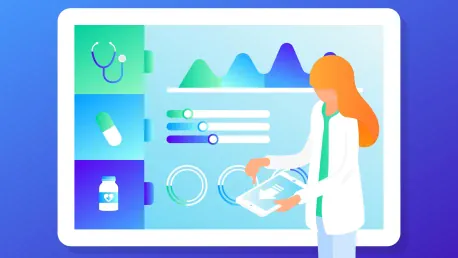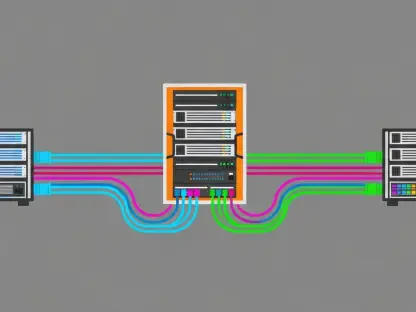In today’s rapidly evolving healthcare landscape, the importance of data management cannot be overstated. Healthcare organizations are increasingly recognizing the need to adopt a unified data strategy to enhance operational efficiency, improve patient outcomes, and keep pace with modern healthcare demands. This article explores the essential strategies for healthcare providers to navigate and leverage complex data landscapes effectively.
The Importance of a Unified Data Strategy
Addressing Data Silos and Fragmentation
Healthcare organizations often struggle with fragmented data systems and data silos, which obstruct the efficient use of data for strategic insights. These silos can lead to incomplete patient records, redundant tests, and misinformed decision-making. By integrating data systems, healthcare providers can ensure that all relevant information is accessible and actionable, leading to better patient care and streamlined operations. A unified data strategy aims to dismantle these barriers, fostering a more cohesive and efficient information flow throughout the healthcare organization.
Effective integration of data systems involves leveraging modern technologies such as cloud computing, interoperable software solutions, and robust data governance frameworks. These technologies can merge disparate data sources into a central repository, making it easier to access and analyze patient information. Additionally, having a unified data strategy promotes a more collaborative environment among healthcare professionals. It enables clinicians, administrators, and IT staff to have a shared understanding of data, leading to more informed decisions and improved patient outcomes.
Navigating Compliance and Cybersecurity Challenges
Evolving compliance requirements and rising cybersecurity threats add layers of complexity to effective data management. Healthcare organizations must stay abreast of regulations such as HIPAA and GDPR while implementing robust cybersecurity measures to protect sensitive patient data. A unified data strategy helps in meeting these compliance mandates and mitigating risks, ensuring that patient information remains secure and confidential. Adopting best practices for data encryption, access controls, and continual monitoring can fortify the defenses against potential breaches and regulatory infringements.
Moreover, a structured data strategy facilitates regular audits and assessments, which are critical for maintaining compliance and identifying vulnerabilities. By systematically organizing and documenting data processes, healthcare providers can more easily demonstrate adherence to regulatory standards, thus reducing the risk of sanctions or penalties. Additionally, incorporating advanced security measures such as multi-factor authentication (MFA) and intrusion detection systems (IDS) further strengthens the security framework. This proactive approach not only safeguards sensitive information but also builds trust with patients and stakeholders, underpinning the ethical management of healthcare data.
Enhancing Data Literacy in Healthcare
Building a Culture of Data Literacy
Data literacy is pivotal for enabling IT leaders and healthcare professionals to fully harness the potential of their data assets. By fostering a culture of data literacy, organizations can improve their ability to analyze and interpret data, driving better decision-making and patient outcomes. Training programs and continuous education initiatives can help healthcare staff develop the necessary skills to work with data effectively. Cultivating a workforce proficient in data analytics will empower them to extract meaningful insights, which can be used to enhance clinical practices and operational efficiencies.
To instill this culture, healthcare organizations should invest in comprehensive training programs that cover the fundamentals of data literacy, including data interpretation, statistical analysis, and the use of analytic tools. Interactive workshops and e-learning modules can be tailored to different roles within the organization, ensuring that all staff members, from clinicians to administrators, are equipped with the skills needed to navigate the data landscape. Additionally, fostering an environment that encourages data-driven decision-making can further reinforce the importance of data literacy, making it an integral part of the organizational culture.
Empowering Healthcare Professionals with Data Insights
Empowering healthcare professionals with data insights allows them to make informed decisions at the point of care. Access to real-time data can help clinicians develop personalized care plans, predict patient risks, and improve treatment outcomes. By leveraging data analytics, healthcare providers can enhance patient care and achieve better health outcomes. This empowerment not only improves clinical efficiency but also fosters a patient-centered approach that is responsive to individual needs and preferences.
Implementing advanced analytic tools such as predictive modeling and machine learning algorithms can provide clinicians with actionable insights based on historical and real-time data. These tools can identify potential health risks, suggest preventive measures, and recommend tailored treatment options, thereby enhancing the quality of care. Furthermore, incorporating data analytics into everyday clinical practices encourages a proactive approach to healthcare, where decisions are driven by evidence and data rather than intuition alone. This transformation from reactive to predictive care can significantly improve patient satisfaction and health outcomes, establishing a more resilient and adaptive healthcare system.
Operational Efficiency Through Data Analytics
Streamlining Hospital Operations
Data analytics can be used to streamline hospital operations, reduce wait times, and improve patient flow and throughput. By analyzing data on patient admissions, discharges, and transfers, healthcare organizations can optimize resource allocation and ensure that patients receive timely care. This leads to increased operational efficiency and a better patient experience. Efficiently managing bed occupancy and staff allocation ensures that hospitals can handle high patient volumes without compromising on the quality of care provided.
Furthermore, data analytics can help in identifying bottlenecks within hospital processes and suggest effective solutions to alleviate these issues. For instance, predictive analytics can forecast peak admission periods, allowing hospitals to prepare in advance and allocate resources accordingly. Real-time dashboards and monitoring tools can provide hospital administrators with a holistic view of operations, enabling them to make informed decisions quickly and responsively. By continuously assessing and refining operational workflows through data-driven insights, hospitals can achieve sustained improvements in efficiency and patient satisfaction.
Managing Costs and Resource Allocation
Financial performance is a crucial aspect of healthcare management. Analytics can be leveraged to manage costs, optimize resource allocation, and improve billing accuracy. By identifying areas of inefficiency and implementing data-driven solutions, healthcare providers can reduce operational costs and enhance financial performance. Effective resource management is particularly important in an environment where healthcare costs are continually rising, and budgets are becoming increasingly constrained.
Cost management through analytics involves detailed tracking of expenses, utilization of resources, and identification of cost-saving opportunities. For instance, by analyzing procurement data, hospitals can negotiate better terms with suppliers and reduce supply chain costs. Furthermore, predictive analytics can identify trends in patient care that lead to excessive costs, enabling healthcare providers to implement preventive measures and optimize treatment protocols. Improving billing accuracy through the use of automated systems and data validation can minimize revenue leakage, ensuring that healthcare providers are reimbursed correctly and promptly for services rendered.
Quality Improvement and Outcome Measures
Focusing on Key Outcome Measures
Quality improvement initiatives are essential for driving continuous improvements in patient care. By focusing on key outcome measures such as mortality rates, readmission rates, and variable costs per case, healthcare organizations can identify areas for improvement and implement targeted interventions. Data analytics plays a central role in monitoring these metrics and guiding quality improvement efforts. Through continuous assessment and refinement, healthcare organizations can foster a culture of excellence that prioritizes patient safety and quality of care.
Leveraging data to monitor quality metrics enables healthcare providers to benchmark performance against industry standards and identify best practices. Automated data collection and reporting systems facilitate real-time tracking of outcome measures, making it easier to identify trends and areas requiring attention. Implementing corrective actions based on data-driven insights can significantly improve patient outcomes, reduce adverse events, and enhance overall healthcare quality. Additionally, involving multidisciplinary teams in quality improvement initiatives ensures that diverse perspectives are considered, leading to more holistic and effective interventions.
Leveraging Predictive Analytics for Strategic Decision-Making
Predictive analytics is a powerful tool for informed decision-making and strategic planning. By analyzing historical data and identifying trends, healthcare providers can anticipate future needs and make proactive decisions. This approach helps in optimizing resource allocation, improving patient care, and achieving long-term strategic goals. Predictive models can anticipate patient demand, identify potential health risks, and forecast financial performance, enabling healthcare organizations to plan more effectively and allocate resources strategically.
Incorporating predictive analytics into strategic planning allows healthcare providers to stay ahead of emerging trends and challenges. For instance, predictive algorithms can identify populations at high risk of chronic diseases, allowing healthcare providers to implement preventive measures and targeted interventions. By anticipating future healthcare needs, organizations can also plan for infrastructure expansions, workforce requirements, and technological advancements. This forward-thinking approach enhances resilience and adaptability, ensuring that healthcare providers can continue to deliver high-quality care in a rapidly changing environment.
Technology Integration and Innovation
Integrating Advanced Analytics Tools
Technology integration is a crucial component of a data-driven healthcare strategy. Advanced analytics tools must be seamlessly integrated with existing healthcare IT systems to facilitate comprehensive data analysis. This integration supports innovation and research, enabling healthcare providers to harness data for developing new treatments and technologies. Seamless integration ensures that data from various sources is unified, accurate, and readily accessible, fostering a more efficient and innovative healthcare environment.
The successful integration of analytics tools involves selecting the right technologies that align with organizational goals and ensuring compatibility with existing systems. Cloud-based platforms, interoperable software solutions, and scalable architectures are essential components of this integration. Additionally, training and support for healthcare professionals in using these tools are critical to maximizing their potential and ensuring smooth adoption. By establishing a robust technological infrastructure, healthcare organizations can create a data ecosystem that promotes continuous improvement, research, and innovation.
Harnessing Data for Research and Development
Data-driven research and development lead to new treatments and technologies, such as AI and machine learning adoption in analytics. By leveraging data for research, healthcare organizations can drive innovation and improve patient outcomes. This approach fosters a culture of continuous improvement and positions healthcare providers at the forefront of medical advancements. Through rigorous data analysis, researchers can uncover novel insights, develop innovative treatment protocols, and enhance the efficacy of existing therapies.
The integration of AI and machine learning in healthcare analytics opens new avenues for precision medicine and personalized care. These technologies can analyze vast datasets to identify patterns, predict outcomes, and recommend tailored treatment options. Furthermore, data-driven research accelerates the discovery and development of new drugs, medical devices, and diagnostic tools, shortening the time from research to patient care. By prioritizing research and development, healthcare organizations can contribute to the advancement of medical science and improve the overall quality of care delivered to patients.
Ensuring Regulatory Compliance Through Analytics
Meeting Healthcare Regulations and Standards
Ensuring regulatory compliance through analytics is essential for meeting healthcare regulations and standards. A structured approach to compliance helps healthcare organizations navigate complex regulatory landscapes and avoid penalties. By leveraging data analytics, providers can monitor compliance metrics and implement corrective actions as needed. This proactive approach ensures that healthcare organizations not only meet but exceed regulatory requirements, fostering a culture of accountability and excellence.
Implementing compliance analytics involves the use of advanced tools and systems to continuously monitor adherence to regulatory standards. Automated reporting and audit functionalities ensure that any deviations from compliance are promptly identified and addressed. Additionally, maintaining comprehensive documentation of compliance-related activities and decisions facilitates transparency and accountability. By integrating compliance analytics into everyday operations, healthcare providers can achieve a higher level of regulatory adherence, enhance patient trust, and mitigate the risks associated with non-compliance.
Aligning Data Strategy with Core Goals
In today’s fast-paced healthcare environment, the significance of effective data management is higher than ever. Healthcare organizations are increasingly realizing the necessity of adopting a unified data strategy to boost operational efficiency, enhance patient outcomes, and stay current with today’s healthcare requirements. A well-structured approach to data management not only helps in streamlining processes but also in making informed decisions, which are critical for patient care.









